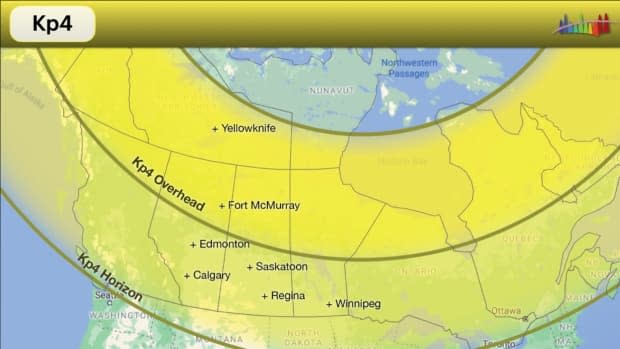Keep an eye out for a chance of northern lights tonight

The sun has burped out a stream of particles that, if conditions are right, might produce northern lights across Canada tonight.
While there's never a guarantee that the northern lights, or aurora borealis, will be visible on any given night, even when there's an increase in activity, the U.S. National Oceanic and Atmospheric Administration's Space Weather Prediction Center (SWPC) reported a strong geomagnetic storm Wednesday. The only catch is that it was daylight across Canada.
Sunspots are cooler regions of the sun. How many appear on the sun's surface depends on what cycle the sun is in. Every 11 years our star goes through a maximum, followed by a minimum (the entire magnetic cycle of the sun, when the poles flip, is 22 years).
The sun is always active, but it goes through a maximum and minimum on an 11-year cycle. During a maximum — which has just begun — the activity increases and there are more sunspots. These spots, which are cooler regions, have a complicated magnetic field. When they become tangled, they can release solar flares.
Often, these flares are followed by a coronal mass ejection, or CME, a fast-moving burst of charged particles, that, if they hit Earth, can interact with our magnetic field and produce the beautiful dancing lights we've come to love. In this case, a CME left the sun on May 9.
Geomagnetic storms range on a scale of one to five. Wednesday afternoon's storm was a three. There is a possibility that it could drop to a two later in the evening.
How to see the the northern lights
There's no guarantee of the northern lights, but you can take steps to increase your chances.
The first thing you might want to do is to check out how active the aurora may be. The SWPC measures the strength of storms on a Kp index. A Kp index of 4 means you're likely to be able to see the lights in dark skies along the horizon (though in places like Toronto and Southern Ontario, it may be a bit more difficult).
A Kp Index of 5 and higher and you have a better chance. As usual with any celestial event, try to get out to a dark site. If you check out the site from time to time, you might get a better idea of your chances. Just look to the north.
The Kp reached 7 during the day on Wednesday. The hope is that it stays somewhere near there, with the doughnut-shaped aurora hole (along which the northern lights travel) dips south, allowing for viewing in more southern latitudes.

But it's important to remember that a lot of things need to line up for them to be visible, and there's no guarantee.
"There's a chance, but I wouldn't bet the farm on it," said seasoned aurora chaser Chris Ratzlaff of Airdrie, Alta. "Aurora does what aurora wants to do, and really nobody knows what it's going to do."
But if you head out tonight and don't get a chance to see them, you can just chalk it up to a night under the stars.

 Yahoo Movies
Yahoo Movies 